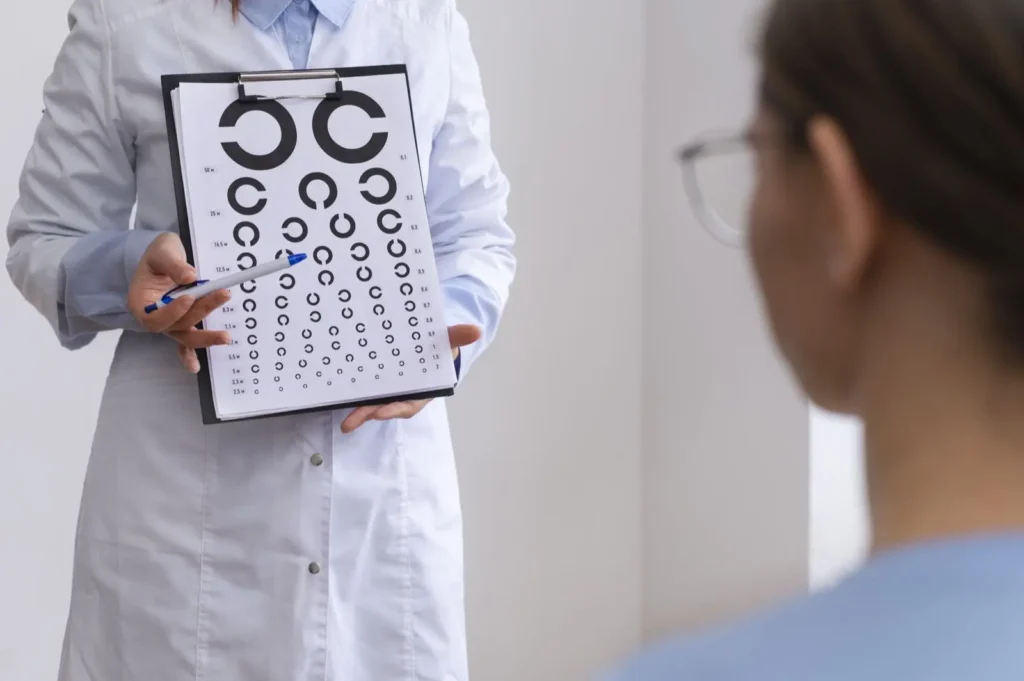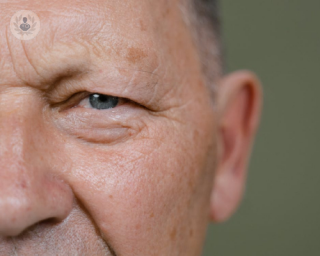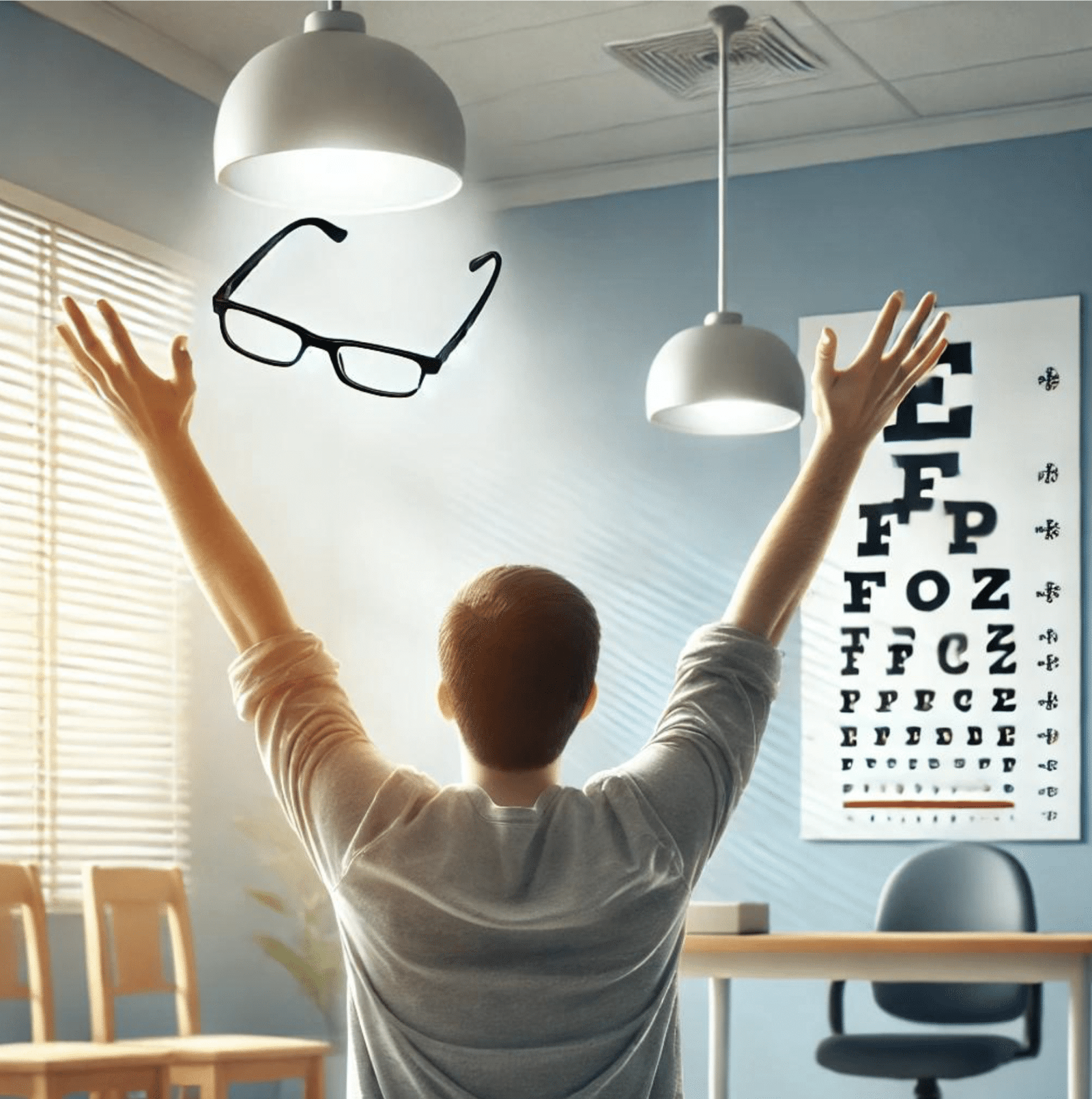The farsightedness and the astigmatism are common visual refractive defects which affect the ability to see clearly. Both can occur together and cause vision difficulties, both near and far. It is essential to know their characteristics and symptoms for a proper diagnosis. Early detection and treatment are key to improving the quality of life of those suffering from these conditions.
At the Dr. Ali Nowrouzi Clinic in Marbella, we have a specialised team and state-of-the-art technology for the diagnosis and treatment of these visual defects. With more than 15 years of experience and thousands of satisfied patients, Dr. Nowrouzi is one of the world's 50 most prestigious specialists in refractive surgery.
Overview of farsightedness and astigmatism
Farsightedness and astigmatism are visual conditions that alter the way light is focused in the eye. Understanding these conditions is crucial to properly addressing the vision problems they can cause.
Definition of farsightedness
This refractive defect occurs when light rays entering the eye are focused behind the retina. This can occur due to an increased length of the eyeball or insufficient curvature of the cornea. People with hyperopia experience difficulty seeing near objects, which can lead to blurred vision and eye fatigue.
Definition of astigmatism
Astigmatism is caused by an irregular curvature of the eye. cornea or lens, which causes light to focus on multiple points in the eye. retina. As a result, vision may be distorted or blurred for both near and distant objects. This condition, whose corneal shape can look more like a rugby ball, makes it difficult to focus images properly.
If you suspect that you suffer from farsightedness or astigmatism, do not hesitate to contact Dr. Ali Nowrouzi Clinic for a complete assessment in Marbella. More information about Dr. Ali Nowrouzi can be found on his official website: Dr. Ali Nowrouzi: Ophthalmologist in Marbella.

Differences between farsightedness and astigmatism
Both conditions have distinct characteristics that affect vision in different ways. The key differences are outlined below:
- Light focusIn hyperopia, light is focused behind the retina, whereas in astigmatism there are several points of focus due to irregular curvature.
- Corneal symmetryHyperopia does not necessarily imply irregularities in the shape of the cornea, unlike astigmatism, which is characterised by such irregularity.
- Affected visionFarsightedness: Those with hyperopia find it difficult to see near objects, while astigmatism causes blurring at all distances.
- DiagnosisAlthough both conditions can be diagnosed by visual examination, the specific tests may differ depending on the type of disorder.
Causes of refractive errors
Refractive defects are caused by multiple factors that affect the shape and function of the eye. These abnormalities can result from variations in the size of the eyeball, the curvature of the cornea or the ability of the lens to focus light correctly.
Causes of farsightedness
Farsightedness occurs mainly due to a shorter than normal axial length of the eyeball or insufficient curvature of the cornea. These conditions prevent light rays from focusing directly on the retina, making it difficult to see near objects clearly.
- Short axial lengthWhen the eye is shorter than normal, incoming light rays are focused behind the retina.
- Insufficient corneal curvatureA less pronounced cornea makes it more difficult to focus light correctly on the retina.
- Variations in the crystalline lensA lens that cannot change its shape properly also contributes to farsightedness.
Causes of astigmatism
This refractive defect arises from an irregular curvature in the cornea or lens, resulting in the focusing of light at various points on the retina. This irregularity may be congenital or develop over time.
- Irregular corneal curvatureInstead of having a symmetrical shape, the cornea may resemble a rugby ball.
- Alterations in the crystalline lensAn irregularly shaped lens will affect focus, resulting in distorted images.
- Previous injuries or surgerySome trauma or treatments may alter the normal curvature of the eye.

Hereditary and environmental factors
Both types of refractive errors can be influenced by genetic and environmental factors. Genetic predisposition to farsightedness or astigmatism increases the likelihood of these disorders occurring in individuals from the same family.
- InheritanceHyperopia tends to be more common in certain families, suggesting a strong genetic component.
- Environmental factorsExcessive use of electronic devices and lack of natural light can increase eye strain, exacerbating refractive conditions.
- Pre-existing health conditionsSome metabolic or systemic diseases can affect eye health and contribute to the development of these defects.
Common symptoms and detection
Identify the symptoms of farsightedness and astigmatism is essential for a proper diagnosis. Recognising these early signs can facilitate correct intervention and improve the patient's visual quality.
Symptoms of farsightedness
This refractive defect has characteristic signs that can be noticed by sufferers. The most common symptoms include:
- Difficulty in clearly seeing objects that are close by.
- Blurred vision during reading or when performing activities that require close focus.
- Eye fatigue after performing near vision tasks.
- Frequent headaches, especially after activities that require visual concentration.
In children, these symptoms may go unnoticed, but they can influence their visual development and cause additional problems if not corrected in time.
Symptoms of astigmatism
Visual distortion is the most representative sign of astigmatism. Other symptoms include:
- Blurred vision at various distances, both from distant and near objects.
- Difficulties in distinguishing fine details, such as small letters or moving elements.
- Distorted or altered images, which can lead to visual confusion.
- Eye fatigue and visual discomfort after prolonged periods of eye use.
These symptoms can also vary in intensity, depending on the severity of the astigmatism, and can impact on the individual's daily life.

Importance of early diagnosis
Detecting farsightedness and astigmatism at an early stage is crucial to prevent further complications. Early diagnosis can:
- Facilitate appropriate correction with glasses or contact lenses.
- Prevent the development of more serious visual conditions, such as amblyopia in childhood.
- Improve quality of life, enabling people to carry out their daily activities without visual discomfort.
It is therefore advisable to have regular ophthalmological check-ups to identify these refractive problems and ensure proper care.
At Dr. Ali Nowrouzi Clinic in Marbella, we offer accurate diagnoses and personalised care to ensure the health of your eyes. Schedule your free initial consultation to evaluate your vision with a world-renowned specialist. For more details about the importance of early detection, you can visit reliable sources such as the American Academy of Ophthalmology.
Diagnosis in consultation
Diagnosis is a crucial step in addressing refractive vision problems. Through comprehensive assessments and specialised methods, the visual conditions present can be properly identified.
Essential ophthalmological tests
At the consultation, various tests are performed to determine visual acuity and the general condition of the eyes. Some of the most common tests include:
- Optotypes: These are tables containing letters or symbols that allow the ophthalmologist assess the clarity of vision at different distances.
- RefractionThis process consists of determining the degree of optical correction required by means of special lenses, thus making it possible to identify existing refractive defects.
- Corneal topographyThis technique maps the curvature of the cornea, providing information about irregularities that could indicate astigmatism.

Eye health assessment
General eye health is fundamental in the diagnosis of any visual defect. A complete examination includes assessment of:
- Intraocular pressure: Measuring the pressure inside the eye helps to rule out glaucoma and other conditions.
- Fundus examinationThis test allows us to observe the state of the retina and the optic nerve, which is crucial for detecting possible complications.
- Corneal and lens healthThe transparency and curvature of these structures is vital to identify problems such as astigmatism.
Use of advanced diagnostic technology
Technological innovations have transformed diagnostic methods in ophthalmology. Modern tools allow for more accurate and efficient assessments. These include:
- Cunt ScannersThese machines use lasers to create detailed images of the ocular surface, helping to detect abnormalities in the curvature of the cornea.
- Optical coherence tomography (OCT)This technique provides high-resolution images of the different layers of the retina, allowing for a more comprehensive diagnosis.
- VideoemoscopyThe function is to analyse the shape and movement of tears, which is essential for eye health and visual quality.
At Dr. Ali Nowrouzi Clinic in Marbella, we use state-of-the-art technology such as femtosecond laser, aberrometry and high-resolution corneal topography for meticulous diagnosis and top quality visual results. Your vision deserves the best attention. Find out more about our diagnostic services at Refractive surgery in Marbella - Dr. Ali Nowrouzi.

Treatment options
There are different ways to address the vision problems of patients with hyperopia and astigmatism. Treatments may vary depending on the severity of the condition, the patient's preferences and lifestyle.
Glasses to correct farsightedness and astigmatism
Spectacles are one of the most common and effective solutions to correct these visual defects. They allow patients to obtain clear and comfortable vision.
- Converging and cylindrical lens designLenses designed for farsightedness are convergent, which helps focus light directly onto the retina. Cylindrical lenses, on the other hand, are used to correct astigmatism by adjusting the curvature of light entering the eye. The combination of both types of lenses is essential for those who suffer from both conditions.
- Advantages of glasses:
- Easy adaptation and daily use.
- Various aesthetic options according to the patient's preferences.
- They do not require surgical intervention.
- Lower risk of complications compared to other treatments.
Contact lenses as an alternative
For those who prefer not to wear spectacles, the contact lenses are a viable option. They fit directly on the surface of the eye, offering greater comfort in certain situations.
- Types of contact lenses:
- Soft lenses: Very popular for their comfort and ease of use.
- Rigid gas permeable lenses: They offer sharper vision and are useful for correcting astigmatism.
- Toric lenses: Specifically designed to correct astigmatism.
- Care and maintenance of lensesIt is important to follow a proper cleaning and care regimen for contact lenses to prevent infection and ensure their durability. The use of appropriate cleaning solutions and adherence to specialist recommendations are essential.
Refractive surgery as a permanent solution
Surgical procedures represent an option for those seeking a more permanent solution for correcting the farsightedness and astigmatism. These techniques can offer significant and lasting results.
- LASIK and PRK procedures: The LASIK and the PRK are two of the most common procedures in the refractive surgery. In LASIK, a flap is created in the cornea to apply the laser directly to the corneal tissue. In PRK, the outer layer of the cornea is removed before the correction is made. Both methods aim to shape the cornea so that the light rays are focused correctly on the retina.
- Potential risks and benefitsWhile this option can provide independence from glasses, it also carries certain risks. Benefits include improved vision and freedom from dependence on glasses, while risks may include postoperative complications and the need for additional adjustments in some cases. Preoperative assessment is crucial in determining the patient's suitability for surgery.
At Dr. Ali Nowrouzi Clinic in Marbella, Dr. Nowrouzi, an expert in refractive surgery, offers personalised laser and intraocular lens treatments designed to improve your vision beyond conventional standards. We have a modern, minimally invasive approach, with over 2,000 satisfied patients. Visit our Refractive surgery in Marbella for more information or call +34 620 68 66 45 to schedule your consultation.

Living with farsightedness and astigmatism
Adjusting to farsightedness and astigmatism may require some changes in daily routine. Incorporating appropriate strategies can help improve quality of life when managing these visual disorders.
Tips to improve quality of life
Implementing certain recommendations can be beneficial for those who suffer from these refractive errors. Some tips are:
- Maintain good lighting when performing tasks that require concentration, such as reading or using electronic devices.
- Take frequent breaks when working on close tasks to reduce eye fatigue.
- Wear appropriate corrective lenses that have been prescribed by a specialist, making sure they are in good condition.
- Practise visual exercises that can help relieve eye strain and improve focus.
Daily activities and visual exercises
Incorporate visual exercises in daily routine can be key to alleviating symptoms. Alternating between near and far objects can help train the eye muscles and reduce strain. Some useful exercises include:
- Fix your eyes on a distant object for 20 seconds, then on a nearby object for another 20 seconds.
- Make circular movements with the eyes, clockwise and then anticlockwise.
- Blink frequently to keep eyes hydrated and rested.
For more information on eye exercises and general eye health, you can consult resources such as the National Eye Institute.

The importance of regular reviews
The ophthalmological check-ups are essential for monitoring eye health and adjusting treatments if necessary. A regular check-up helps detect changes in vision early and can prevent visual impairment. Recommended:
- Attend check-ups at least once a year or as directed by your eye care professional.
- Report any new symptoms or changes in vision to the ophthalmologist.
- Consider additional testing if there is a family history of refractive problems.
Dr. Ali Nowrouzi Clinic in Marbella is located at Av. Severo Ochoa, 19, 29603 Marbella, Malaga. We offer a free initial consultation and flexible financing options. Your visual health is our priority.
Emerging and future technologies
Technological advances in the field of ophthalmology are transforming the way refractive errors are diagnosed and treated. Recent research and innovations promise a future where the treatment of conditions such as farsightedness and astigmatism will be more effective and accessible.
Advances in laser treatments
Laser treatments are constantly evolving, improving in precision and safety. These procedures, which have gained popularity, not only correct vision, but also minimise recovery time and associated risks. Some of the latest techniques include:
- Custom LASIKThe treatment is tailored to the specific needs of each patient using advanced technology, ensuring more precise results.
- SMILE (Small Incision Lenticule Extraction)A minimally invasive procedure that corrects refractive errors with a small incision, reducing ocular trauma.
- Laser-Assisted Sub-Epithelial Keratectomy (LASEK)Offers an alternative to LASIK for patients with thin corneas, preserving the integrity of the corneal tissue.
State-of-the-art intraocular lenses
The intraocular lenses advanced lenses are revolutionising the way certain cases of hyperopia and astigmatism are treated, especially in patients who are not candidates for refractive surgery. These lenses are designed to correct various refractive defects and can be implanted during surgical procedures. Features include:
- Multifocal lensesThey allow vision at different distances, reducing dependence on glasses after surgery.
- Toric lensesSpecifically designed to correct astigmatism and improve the patient's quality of vision.
- Intraocular camerasInnovative technology that allows for greater personalisation of treatment and more effective adaptation to the patient's visual needs.
Innovations in ophthalmology for the future
Research in ophthalmology focuses on the development of new techniques and tools that can change the landscape of refractive defect treatment. Some of these innovations include:
- Artificial intelligence for diagnosticsAI tools that help to make more accurate and personalised diagnoses, improving patient care.
- Advanced eye sensorsThese technologies enable real-time monitoring of eye health, facilitating early detection of problems and optimising treatment.
- Tissue regeneration therapiesStem cell and corneal regeneration research could offer lasting solutions to complex visual problems.
At Dr. Ali Nowrouzi Clinic, we pride ourselves on being at the forefront of ophthalmic technologies, offering our patients in Marbella the most advanced and personalised treatments. We are certified as one of the world's top 50 specialists in refractive and cataract surgery. Trust your vision to the experts. You can view patient testimonials at Testimonials and opinions Dr. Ali Nowrouzi.
Frequently asked questions from patients
There are many concerns surrounding vision problems such as farsightedness and astigmatism. This section addresses the most common questions asked by patients, providing clarity on available diagnoses and treatments.
Common doubts about diagnosis
A recurring theme is the way in which these disorders are diagnosed. Patients often wonder:
- How are vision problems determined?
- Is the eye examination painful?
- What kind of tests are carried out in the consultation?
Diagnosis involves a series of non-invasive tests which measure visual acuity and assess the condition of the cornea and other ocular components. These tests allow the specialist to establish an accurate diagnosis.
Concerns about available treatments
Treatment options are varied, which raises many questions for patients:
- What treatments are available for farsightedness and astigmatism?
- Can vision be improved without surgery?
- What are the advantages of glasses over contact lenses?
Treatments may include glasses, contact lenses and refractive surgery. The choice of treatment will depend on the severity of the condition, the patient's preferences and the recommendation of the ophthalmologist.
Choosing the right treatment
Choosing the right treatment can be complicated, as each patient has different needs. Some important considerations are:
- The intensity of the symptoms.
- Daily activities that may be affected.
- The recommendations of the medical specialist based on diagnostic tests.
Open dialogue with the ophthalmologist about the various options allows patients to make an informed decision that fits their lifestyle and visual needs.
For a personalised consultation and to resolve all your doubts, we invite you to visit Dr. Ali Nowrouzi Clinic in Marbella. Our team is committed to providing you with the best solution for your visual health. You can contact us by phone at +34 620 68 66 45 or by email at info@dralinowrouzi.com.







